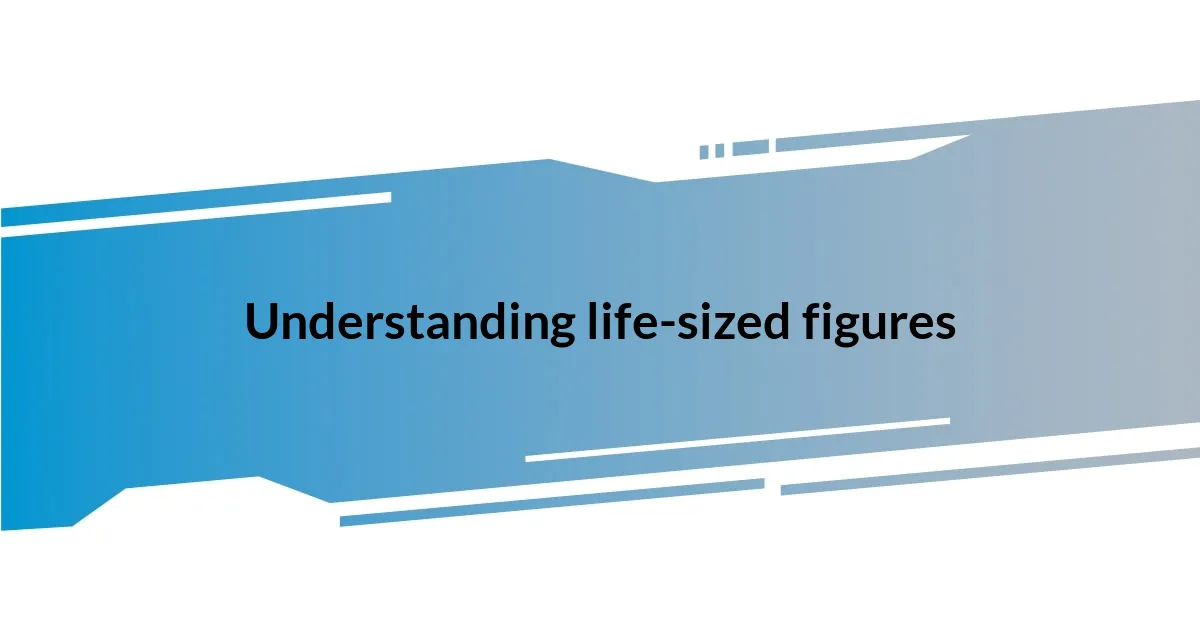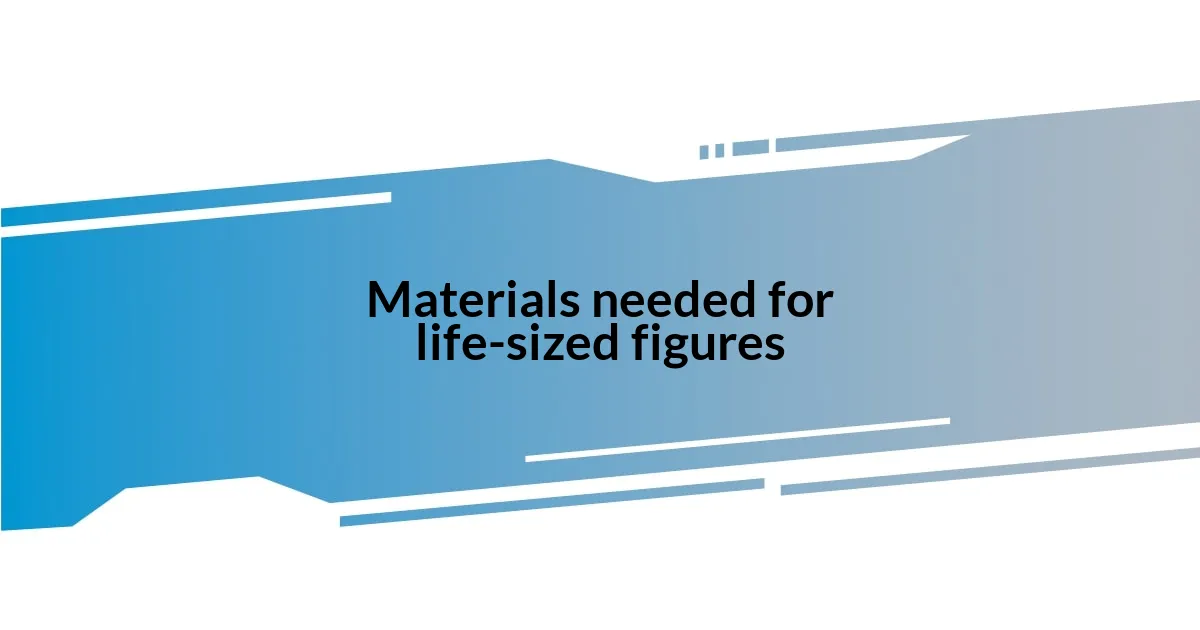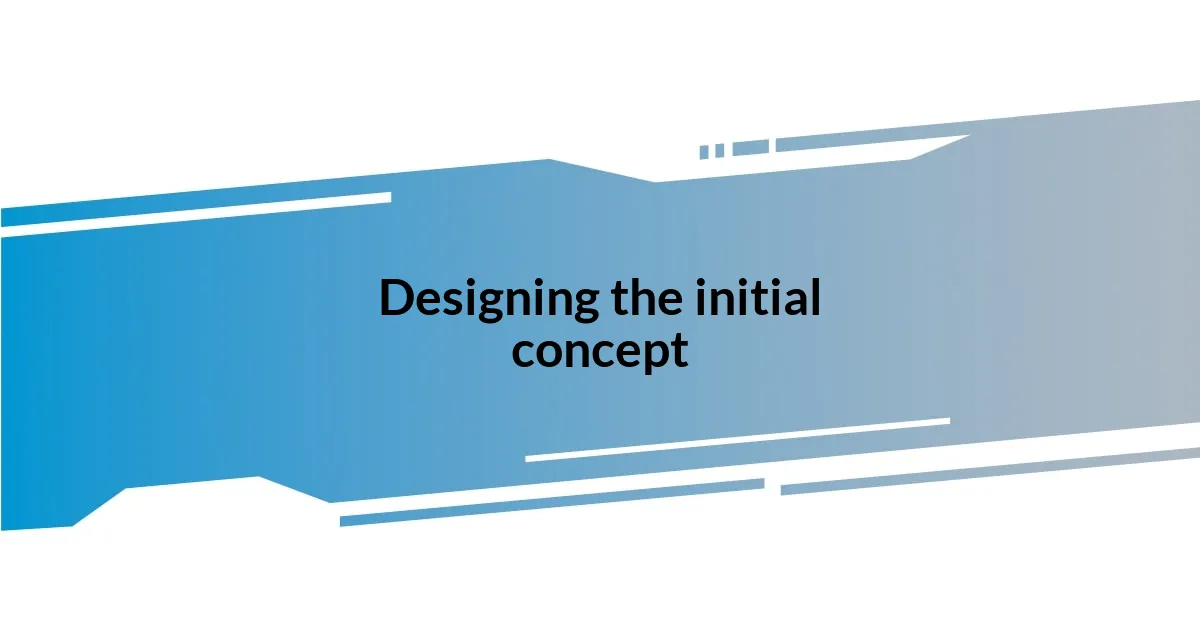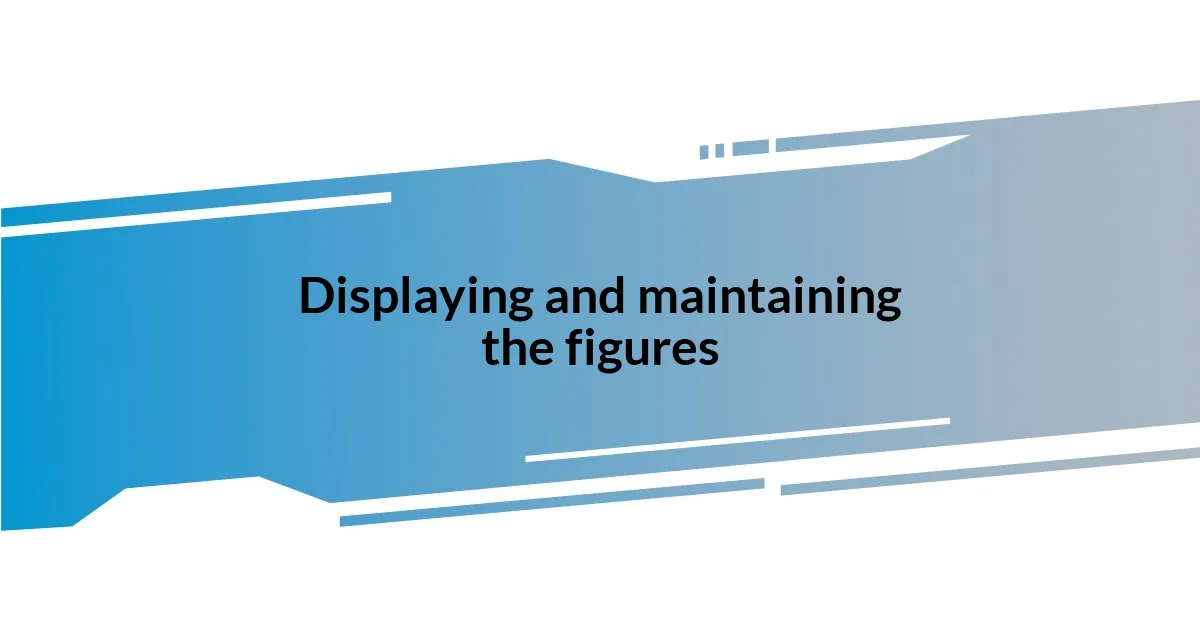Key takeaways:
- Life-sized figures capture human essence and storytelling, connecting emotionally with viewers through details and expressions.
- The selection of materials significantly impacts the figure’s realism and narrative; each material contributes a unique emotional connection.
- Designing the initial concept involves thoughtful consideration of theme, proportions, pose, facial expression, and context to convey the character’s essence.
- Finalizing details, particularly facial expressions and accessories, enhances the figure’s storytelling and emotional depth, transforming it into a more relatable piece.

Understanding life-sized figures
Life-sized figures are not merely replicas of human form; they capture the essence of a person or character in a way that evokes emotion and connection. When I first created a life-sized figure for a community project, I was amazed at how it drew people in. I remember watching kids approach it, eyes wide with curiosity, as if they were meeting a superhero for the first time—what a powerful reminder of how art can spark imagination!
Each life-sized figure tells a story, weaving elements of personality, expression, and context into its design. I recall sculpting a figure of a local historical figure—it became a focal point for storytelling in the neighborhood. Have you ever wondered how a lifeless material can breathe life into shared experiences? For me, that realization was transformative, showing how depth and detail can turn a simple representation into a meaningful cultural touchstone.
The accuracy of proportions and details in life-sized figures is crucial; it’s like creating a bridge between reality and artistic interpretation. When I meticulously worked on capturing the subtleties of facial expressions, it dawned on me how these small details could evoke specific emotions in viewers. Don’t you think it’s fascinating how a slight tilt of the head or the curve of a smile can alter the narrative entirely? That’s the magic of life-sized figures—they invite us to explore the realms of imagination while reflecting our humanity.

Materials needed for life-sized figures
Creating life-sized figures requires a thoughtfully chosen selection of materials. In my experience, I often use a combination of clay, foam, and fabric, each serving distinct purposes. Clay is excellent for detailed features, while foam gives the figure structure and a lighter weight. I still remember my first figure; using foam made it much easier to transport to exhibitions.
As I explored different materials, I discovered that the finish can dramatically alter the final appearance. For a more realistic texture, I opted for silicone over traditional paints, providing a lifelike skin effect. When I used silicone for my recent project, I couldn’t help but marvel at the soft sheen it imparted—it truly brought the figure to life. Have you ever experienced the satisfaction of seeing a creation evolve right before your eyes? There’s nothing quite like that moment!
Each material I choose carries its own emotional weight as well. For instance, working with recycled materials has a unique charm; it feels like I’m giving a second life to something that would have otherwise been discarded. This emotional connection often resonates with viewers. They find beauty in the imperfections, reflecting their own journeys. This experience led me to realize that materials are not just tools; they become part of the narrative.
| Material | Purpose |
|---|---|
| Clay | Detailing facial features |
| Foam | Providing structure and lightweight support |
| Fabric | Adding clothing and texture |
| Silicone | Creating realistic skin textures |
| Recycled materials | Promoting sustainability and personal narratives |

Designing the initial concept
I always begin the journey of creating a life-sized figure with sketching out the initial concept. This phase is a blend of imagination and practicality, where inspiration flows freely. I can still recall sitting in my studio, surrounded by swirls of paper, breathing in the scent of graphite as I mapped out the figure of a beloved local hero. It was more than just drawing; it felt like I was forging a connection with the character, ensuring that every line carried the weight of their story.
To effectively communicate my vision, I keep several key elements in mind during this initial design phase:
– Theme: What story or message do I want to convey?
– Proportions: How do the dimensions reflect the personality of the figure?
– Pose: Which stance captures the essence of the character?
– Facial Expression: What emotions should be evoked through their expression?
– Context: Where will this figure ultimately be displayed, and how does that influence its design?
I find that visualizing the final placement of the figure really helps in making crucial design decisions. For instance, while designing an interactive figure for a children’s museum, I focused on a dynamic pose that would invite visitors to engage. These moments of conceptualization are not just technical; they’re deeply personal, reminding me of my childhood days spent dreaming about superheroes and their adventures.

Building the armature framework
Building the armature framework is a crucial step in bringing life-sized figures to existence. I typically begin with a skeletal design made from metal wire or sturdy PVC pipes. This framework provides essential support and can withstand the weight of the materials I’ll layer on top. I remember my first attempt; the armature collapsed because I hadn’t accounted for the figure’s pose. That taught me the importance of balance and a solid foundation.
Once I have the basic structure in place, I pay close attention to the joints and connections. I’ll often use zip ties or duct tape to reinforce areas that will experience movement or stress. During one project, I was so focused on aesthetics that I neglected the stability of the joints, leading to a figure that couldn’t hold its intended pose. I learned that functionality must never be an afterthought. Do you often contemplate how something that appears simple can become complex? Every joint in my framework is a reminder that robust design is essential for artistic expression.
As I build the armature, I find myself getting excited about how this framework will support the personality of my figure. Each bend and twist in the wire feels like it’s infusing life into the creation. The armature becomes more than just a skeleton; it’s the backbone of the story I want to tell. With every careful adjustment, I envision the final figure and the impact it will have on those who see it. Does it excite you to think about how your creations might come alive in a similar way? It’s a thrilling part of the process that makes the challenges worthwhile.

Applying layers and textures
When it comes to applying layers and textures, I often find myself lost in the tactile nature of the materials. Starting with a base layer of clay, for instance, I meticulously cover the armature, feeling the coolness of the material beneath my hands. This process is where my figure begins to gain physicality and presence, transforming from a mere structure into something that feels almost alive. Have you ever felt that connection with your work, as if you’re nurturing it into existence?
As I apply additional layers, I pay close attention to the textural details that breathe character into the figure. I might use tools like spatulas or even my fingers to create realistic skin textures or fabric effects. I remember experimenting with various fabric layers during a project; the moment I wrapped a piece of satin around the arms, it completely altered the perception of the figure. It was like dressing my creation in an outfit that conveyed its story. Isn’t it fascinating how something as simple as texture can evoke emotions and tell stories?
Color comes next, and it’s when the magic truly unfolds. I layer on paints and finishes, each brushstroke enriching the character’s depth. In one memorable instance, I discovered that adding a subtle wash of color could enhance the shadows and highlights, giving the figure dimension I hadn’t realized it needed. It’s these small, deliberate choices that elevate a life-sized figure from a static sculpture to a dynamic, expressive piece. Have you experienced that “aha” moment when a simple technique transforms your vision? It’s this interplay of layers and textures that captivates both me and my audience, ultimately making the art come to life.

Finalizing details and features
As I reach the stage of finalizing details and features, I often experience a blend of excitement and nervousness. It’s like the final moments of a huge project where every little detail counts. I remember once painstakingly painting a life-sized figure only to realize I hadn’t added the subtle scars that tell its story. Those tiny marks, which I had initially overlooked, transformed the character into something with history and depth. Isn’t it remarkable how the smallest details can shift the narrative entirely?
Getting the facial expressions just right is perhaps the most critical part for me. I habitually spend extra time on the eyes since they can convey so much emotion. I learned this from a previous project where I rushed through the features and ended up with a figure that felt vacant and lifeless. The moment I took a step back and focused on enhancing the eyes, everything changed. They became windows into the character’s soul. Don’t you find it fascinating how a slight tilt of a mouth or a change in the gaze can evoke entirely different feelings?
During this stage, I also reflect on accessories and distinguishing features. These elements are like the icing on the cake—adding that final touch that makes it unique. For instance, I once handcrafted a tiny book for a figure, which held incredible personal significance. It wasn’t just an accessory; it narrated a story of dreams and adventures. That’s when I realized: every item you add has the potential to deepen the viewer’s connection with the piece. What features have you considered including in your creations to tell a richer story? It’s the thrill of this detail-oriented process that truly brings a figure to life, weaving together the many threads of its journey.

Displaying and maintaining the figures
Displaying life-sized figures is an art in itself. I’ve always believed that the environment where you showcase your creations profoundly affects how they’re perceived. For instance, I once displayed a figure in a dimly lit gallery, and it felt like the shadows danced around it, adding an air of mystery. Don’t you think it’s captivating how lighting can transform the mood and draw viewers closer to a piece?
Maintenance is equally crucial. I typically schedule regular check-ups, like a curatorial routine, to dust and examine the figures for any signs of wear. One time, I found a minor crack in a piece after a year on display. That moment reminded me of the importance of upkeep—not just for aesthetics, but for preserving the story the figure tells. Have you ever thought about how care can prolong the life of your creations and enhance their storytelling?
Lastly, the way you position the figures speaks volumes. I recall a time I experimented with angles, placing a figure in a dynamic stance rather than a static pose. The energy it exuded completely changed its narrative. I still ask myself, how can an intentional display reflect the figure’s journey and evoke emotions in the audience? I hope you find that the placement of your figures can elevate their impact, inviting viewers to engage more deeply with their stories.